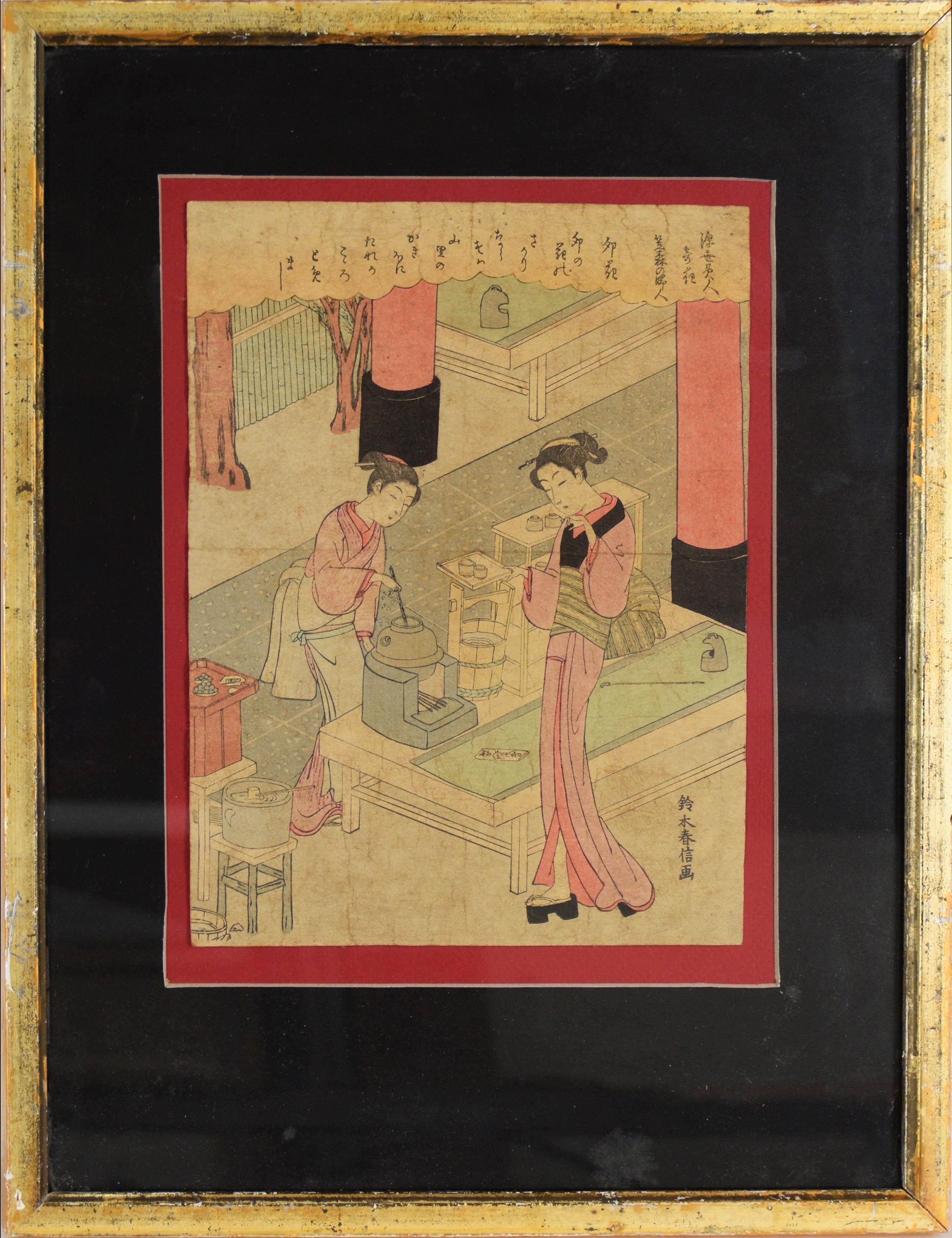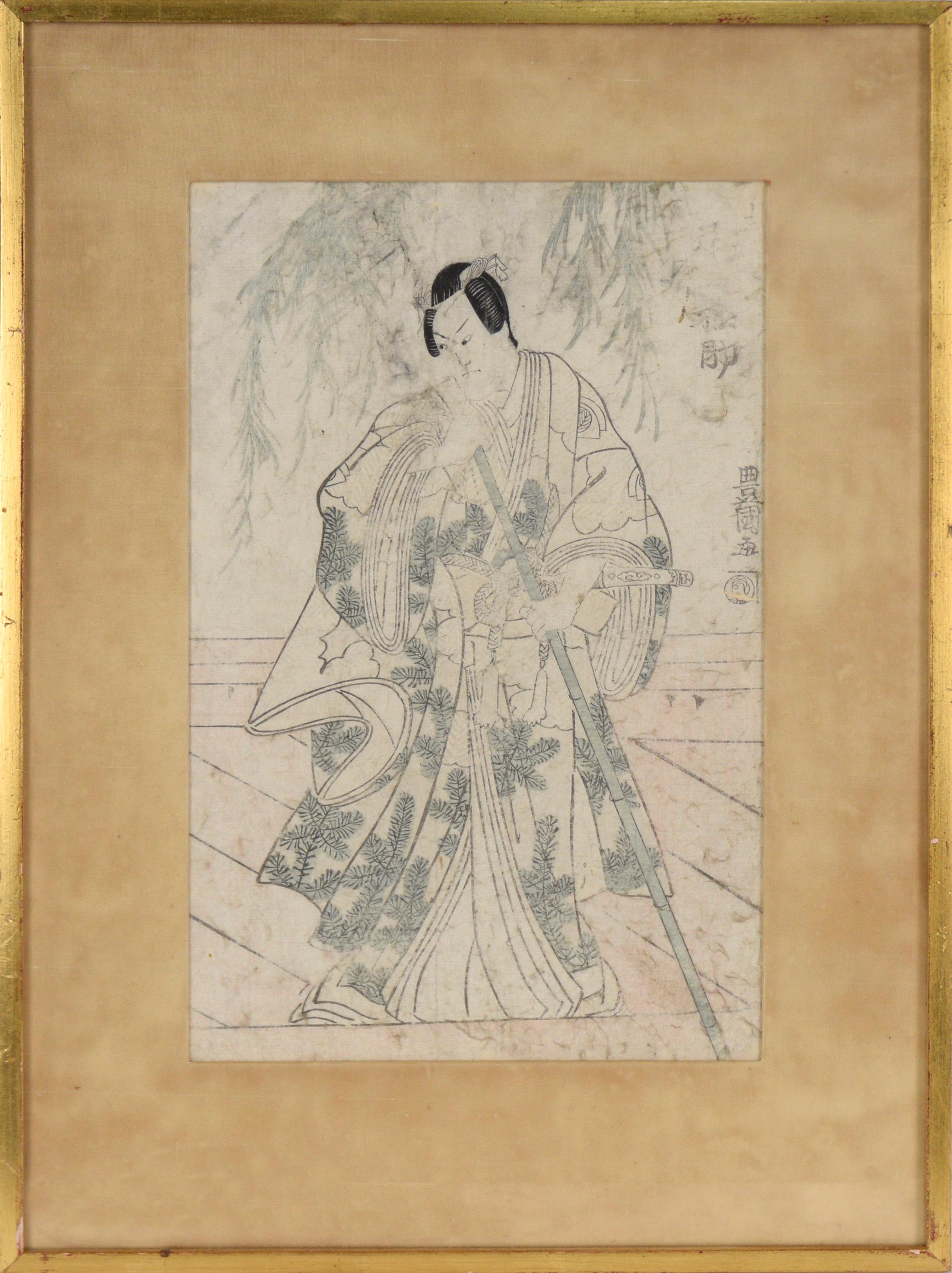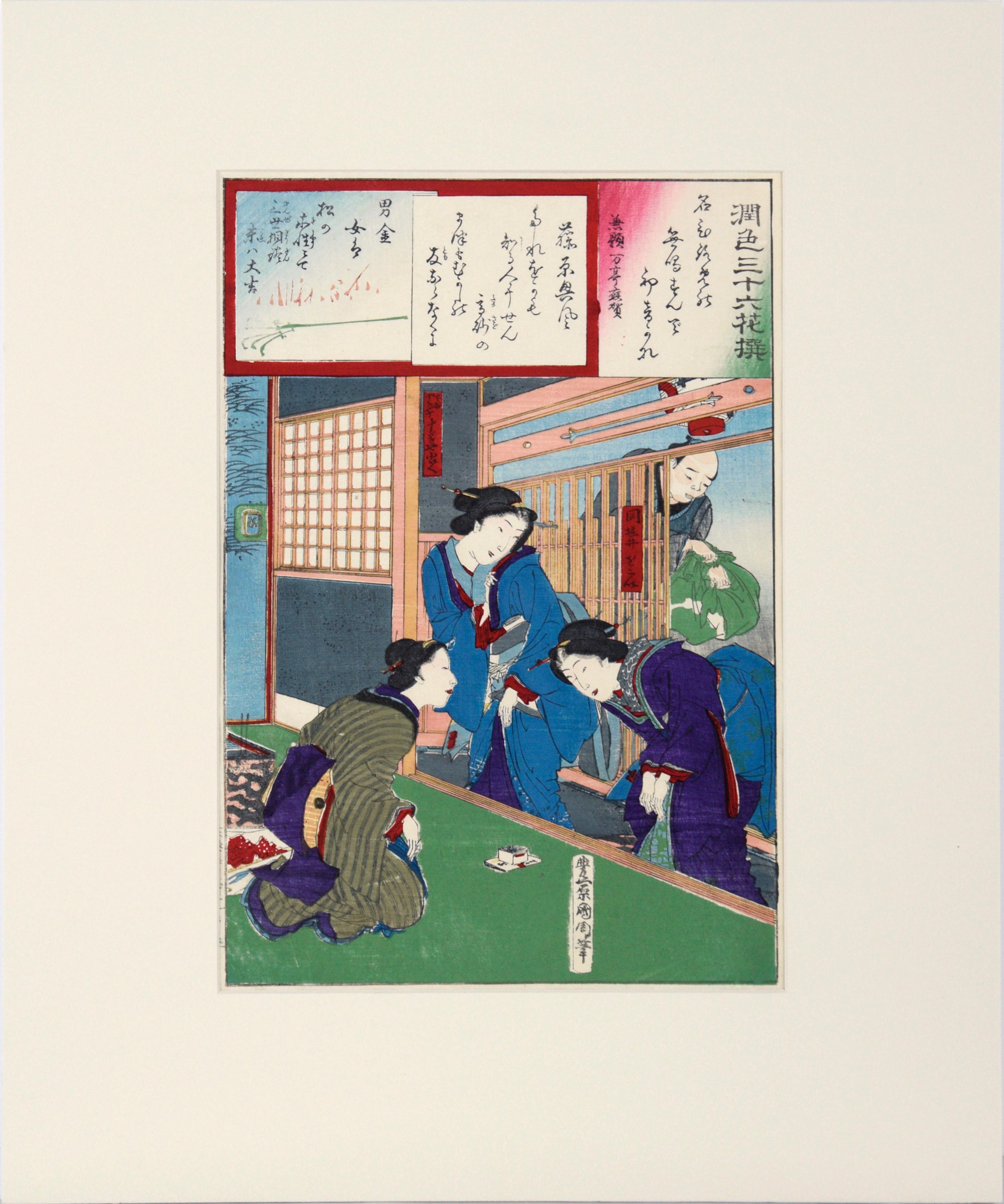Items Similar to Kabuki Actor in Blue Kimono - Original Woodblock Print
Want more images or videos?
Request additional images or videos from the seller
1 of 11
Suzuki HarunobuKabuki Actor in Blue Kimono - Original Woodblock Print1700's
1700's
About the Item
Kabuki Actor in Blue Kimono - Original Woodblock Print
Original woodblock print depicting a Kabuki actor in a blue kimono by Suzuki Harunobu (Japanese, 1725-1770). The actor holds up a sword in his left hand while his right hand is tied in a black rope.
Presented in a wood frame.
Frame: 21.5"H x 16.5"W
Paper: 20.75"H x 15.75"W
Image: 14"H x 10"W
Suzuki Harunobu thus became one of the primary producers of images of bijinga (pictures of beautiful women) and kabuki actors of Edo, and of similar and related subjects for the Edo print connoisseur market. In a few special cases, notably his famous set of eight prints entitled Zashiki hakkei (Eight Parlor Views), the patron's name appears on the print along with, or in place of, Harunobu's own. The presence of a patron's name or seal, and especially the omission of that of the artist, was another novel development in ukiyo-e of this time.
Between 1765 and 1770, Harunobu created over twenty illustrated books and over one thousand color prints, along with a number of paintings. He came to be regarded as the master of ukiyo-e during these last years of his life, and was widely imitated until, a number of years after his death, his style was eclipsed by that of new artists, including Katsukawa Shunshō and Torii Kiyonaga.
In addition to the revolutionary innovations that came with the introduction of nishiki-e, Harunobu's personal style was unique in a number of other respects. His figures are all very thin and light; some critics say that all his figures look like children. However, it is these same young girls who epitomize Harunobu's personal style. Richard Lane describes this as "Harunobu's special province, one in which he surpassed all other Japanese artists - eternal girlhood in unusual and poetic settings". Though his compositions, like most ukiyo-e prints, may be said to be fairly simple overall, it is the overall composition that concerned Harunobu. Unlike many of his predecessors, he did not seek to have the girls' kimono dominate the viewer's attention.
- Creator:Suzuki Harunobu
- Creation Year:1700's
- Dimensions:Height: 21.5 in (54.61 cm)Width: 16.5 in (41.91 cm)Depth: 0.5 in (1.27 cm)
- Medium:
- Movement & Style:
- Period:1760-1769
- Condition:Good condition. Some fading and age toning to paper. Water stains to linen mat.
- Gallery Location:Soquel, CA
- Reference Number:
About the Seller
4.9
Platinum Seller
These expertly vetted sellers are 1stDibs' most experienced sellers and are rated highest by our customers.
Established in 1986
1stDibs seller since 2014
2,548 sales on 1stDibs
Typical response time: <1 hour
- ShippingRetrieving quote...Ships From: Soquel, CA
- Return PolicyA return for this item may be initiated within 14 days of delivery.
More From This SellerView All
- Deutzia Flowers: The Wife of Kasamori - Original Woodblock PrintLocated in Soquel, CADeutzia Flowers: The Wife of Kasamori - Original Woodblock Print Deutzia Flowers: The Wife of Kasamori, from the Series "Beauties of the Floating World Associated with Flowers" by S...Category
1760s Edo Figurative Prints
MaterialsWoodcut, Ink, Rice Paper
- Kabuki Actor with Pine-Patterned Robe - Japanese Woodblock PrintBy Utagawa ToyokuniLocated in Soquel, CAKabuki Actor with Pine-Patterned Robe - Japanese Woodblock Print Finely detailed woodblock by Utagawa Toyokuni (Japanese, 1769-1825). A kabuki actor is standing on a wooden deck, wearing a robe with a pine-needle pattern. He is holding a sword and a staff. In the background, tree branches hang down from out of frame. Presented in a gold colored frame with a silk mat. Frame size: 20"H x 14.25"W Image size: 14"H x 8.5"W Utagawa Toyokuni (Japanese, 1769-1825) was born in Edo, the son of Kurahashi Gorobei, a carver of dolls and puppets...Category
Early 19th Century Edo Figurative Prints
MaterialsInk, Rice Paper, Woodcut
- Kabuki Actor in Water Lily Robe with Samurai Sword - Japanese Woodblock PrintBy Utagawa ToyokuniLocated in Soquel, CAKabuki Actor in Water Lily Robe with Samurai Sword- Japanese Woodblock Print Finely detailed woodblock by Utagawa Toyokuni (Japanese, 1769-1825). A kabuki actor ("Master Haranyuki Sawamura") is standing on stage with mountainous backdrop, wearing a robe in a water lily pattern. He is wearing a samurai sword. Presented in a gold colored frame with a silk mat. Frame size: 20"H x 14.25"W Image size: 14"H x 9"W Utagawa Toyokuni (Japanese, 1769-1825) was born in Edo, the son of Kurahashi Gorobei, a carver of dolls and puppets...Category
Early 19th Century Edo Figurative Prints
MaterialsInk, Rice Paper, Woodcut
- "Enshoku Sanju-roku Kasen" (Thirty-six Enchanting Flowers) Woodblock on paperBy Toyohara KunichikaLocated in Soquel, CA"Enshoku Sanju-roku Kasen" (Thirty-six Enchanting Flowers) Woodblock on paper Elegant woodblock print by Toyohara Kunuchika (Japanese, 1835-1900). Three women are in talking with each other inside, while a man waits outside holding a bag of some kind. The colors in this piece are rich and saturated, primarily blues, greens, and purple. Mat size: 16"H x 20"W Paper size: 14.75"H x 9.88"W Born in 1835, Toyohara Kunichika grew up in the Kyobashi district of Edo in the midst of merchants and artisans. In 1848, at age 13, he was accepted as an apprentice into the studio of Utagawa Kunisada I...Category
1880s Edo Figurative Prints
MaterialsInk, Rice Paper, Woodcut
- Narihira's Journey to the East - Japanese Woodblock on Paper by Kikugawa EizanBy Kikugawa EizanLocated in Soquel, CANarihira's Journey to the East - Japanese Woodblock on Paper Original 19th century Japanese woodcut print depicting Narihira's journey to the East by a follower of Utamaru, Kikugaw...Category
Early 19th Century Edo Figurative Prints
MaterialsWoodcut, Rice Paper, Ink
- "Various Himochi" Wagashi Festival Japanese Woodblock Print by Utagawa ToyokuniLocated in Soquel, CA"Various Himochi" Wagashi Festival Japanese Woodblock Print by Utagawa Toyokuni Rare oversized early 19th century 5-tiered woodblock by Utagawa Ichiyosai Toyokuni, (Japan, 1769-1825), a Japanese lord and wife oversee a sekku festival of food, music, and dolls or toys. '"oshi" is the first day of “Mi (Snake)” in the third month of the lunar calendar. This day, known in modern Japan as the Girls' Festival, originated in China as a form of purification ceremony in which water and drinking peach blossom wine were used to drive away evil. Many kinds of hishi-mochi appear in this picture of hina ningyo (dolls associated with Hinamatsuri, or the Girl’s Day) from Omochae. The custom of eating special dishes at events throughout the year and at milestones in people's lives has existed since ancient times. This paragraph specifically focuses on the annual event called sekku, and life events that involve eating sweets. Joshi is the first day of “Mi (Snake)” in the third month of the lunar calendar. This day, known in modern Japan as the Girls' Festival, originated in China as a form of purification ceremony in which water and drinking peach blossom wine were used to drive away evil. According to the Keiso saijiki, in ancient China, on the third day of the third lunar month, people ate “ryuzetsuhan,” which is the juice of gogyo (Jersey cudweed) mixed with rice flour and nectar. In Japan, there is a record in the Heian period history book Nihon Montoku tenno jitsuroku [839-5] that it was an annual event to make kusamochi using gogyo on the third day of the third month of the lunar calendar, which may have been influenced by Chinese customs. The tradition of eating kusamochi on the third day of the third month of the lunar calendar continued after that. By the Edo period, however, hishimochi had come to be used as a sweet to serve on the third day of the third month. A picture of a hishimochi is included in the Morisada manko , which we mentioned in Part 1. According to it, hishimochi in the Edo period were often three layers of green-white-green instead of the now common red-white-green. However, it is possible to see from our collection that not all hishimochi were made in this way. Omochae published in 1857, is a good example. Omochae is a type of ukiyoe print...Category
1820s Edo Figurative Prints
MaterialsInk, Rice Paper, Woodcut
You May Also Like
- Seishi Ai-oi Genji – Set of 12 Shunga works together w/astrological commentaryBy Utagawa Kunisada (Toyokuni III)Located in Middletown, NYSet of 12 woodblock prints in colors on handmade, laid mulberry paper, 6 3/4 x 10 1/4 inches (170 x 258 mm), printed in Ka-ei 4 (1851). Each print with minor handling wear, otherwise in excellent condition with bright and fresh color, and with details printed in silver ink. The images themselves contain several illusive characters indicating the publisher which are obfuscated by figures, as intended. Presented loose, as issued. A fine set. The astrological commentary print has a large and meandering blind stamp with a bird and palm frond motif. This print lists various phrases concerning the Twelve Zodiac Animals as historically counted in Japan, and appears to include erotic commentary on the traits of people born under each of the twelve signs. These Shunga images were issued in books that paralleled (in an erotic fashion...Category
Mid-19th Century Edo Nude Prints
MaterialsHandmade Paper, Ink, Woodcut
- The Lonely House at Asajigahara.Located in Middletown, NYA scene from a series of ghost stories and spooky rural legends. Tokyo: Matsuki Heikichi, 1896. Woodcut in ink with embossing and hand-coloring in watercolor on handmade mulberry pa...Category
Late 19th Century Edo Figurative Prints
MaterialsWatercolor, Woodcut, Handmade Paper
- Actor Iwai Shigaku as Somenoi in "Denka chaya adauchi"By KuniyoshiLocated in Middletown, NYActor Iwai Shigaku as Somenoi in "Denka chaya adauchi" (Revenge at the Denka Teahouse), by Shigeharu, Ryusai (also called Kuniyoshi) Tokyo: Horie Ichiba Wataki, 1835. Woodcut on la...Category
Early 19th Century Edo Portrait Prints
MaterialsLaid Paper, Handmade Paper, Woodcut
- Dyeing PaperLocated in Middletown, NYJapan: circa 1770. Woodcut on cream laid paper, 7 1/4 x 2 1/2 inches (182 x 63 mm), narrow margins. Laid down to non-archival board with scattered soiling and some adhesive staining...Category
Late 18th Century Edo Figurative Prints
MaterialsHandmade Paper, Woodcut, Laid Paper
- Japanese Beauty Admiring Kirifuri WaterfallBy Yoshu ChikanobuLocated in Burbank, CAA beauty turns to admire the Kirifuri Waterfall in Nikko Province. She holds the handle of an umbrella and wears fashionable clothing that is beautifully printed. This series pairs f...Category
1890s Edo Landscape Prints
MaterialsMulberry Paper, Handmade Paper, Woodcut
- Two Women Playing Sugoroku from "Comparison of the Customs of Beauties."Located in Middletown, NYA scene from a vanishing Japan. Two Women Playing Sugoroku from "Comparison of the Customs of Beauties."; The Customs and Manners of Women Japan: Matsuki Heikichi, 1891. Woodblock ...Category
Late 19th Century Edo Figurative Prints
MaterialsHandmade Paper, Watercolor, Woodcut





